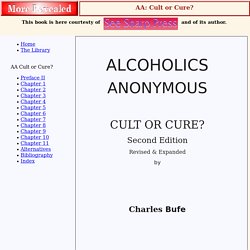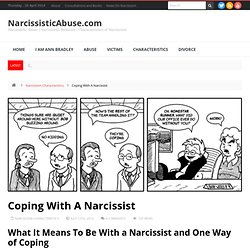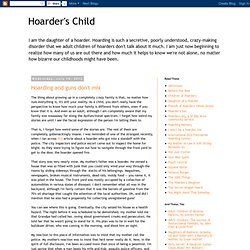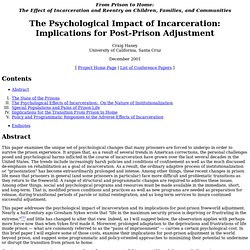

AA: Cult or Cure? Table of Contents. Second Edition Revised & Expanded by Charles Bufe See Sharp Press Tucson, Arizona 1998 Copyright © 1998 by Charles Q.

For more information contact See Sharp Press,
362.292- Dysfunctional Family. 362.29 Addiction in Society. 362.4 - Deaf/HoH. Coping With A Narcissist. What It Means To Be With a Narcissist and One Way of Coping About You It isn’t easy being you.

You might be unsure yourself if you are with an abuser because they can so easily turn on the charm or maybe they might say, “C’mon, aren’t you being too sensitive? What’s the matter with you?” And there you are again, back in the cycle of abuse. It isn’t easy being you whether the abuse is overt or not. So there you are, confused, or maybe not – perhaps you are sure at this point that you are with a narcissist. Doing Nothing Now is the time to do….nothing. You’ve spent so many years feeling down, maybe feeling worthless, and now you want to take action. A Door Positive psychology is one relatively quick intervention that can allow you to get in control to make decisions. This is not “The Secret” Positive psychology is not positive affirmations and visualization.
Depression is not anger turned inward. Positive psychology never disputes reality, it makes reality easier to handle. Learn More. Emotional Dysregulation Disorder. Emotional Dysregulation Disorder (EDD) Introduction Emotional Dysegulation Disorder is a serious condition which is believed to affect between 1-3% of the general population yet despite being so prevalent is not commonly understood.

People who live in a relationship with a person who suffers from borderline personality disorder often know that something is terribly wrong with the behavior of their family member or loved-one but often do not know what to do about it or that there is even a name for it. Alternate Names There are a number of different names used around the world for the same disorder: Borderline Personality Disorder (BPD) Emotional Regulation Disorder (ERD) Emotional Dysregulation Disorder Emotional Intensity Disorder (EID) Emotionally Unstable Personality Disorder (EUPD) Emotion-Impulse Regulation Disorder (EIRD) Impulsive Personality Disorder (IPD) Characteristics & Traits Note that these traits are given as a guideline only and are not intended for diagnosis. BPD Statistics. A Hoarder's Daughter Yields to a (Little) Mess.
Hoarder's Child. The spring weather today made me have a flashback to a Spring Break in high school that I spent organizing my mother's garage.

Ha, you say. What teenage hubris inspired you to attempt to de-hoard a suburban, two-car garage filled solidly with junk stacked higher than you are tall? By yourself? In a week? Well, I wouldn't say it was hubris so much as desperation. My mother is mostly a hoarder of books and paper. And at the end of the week, when I proudly showed my mother my accomplishment -- Look! She let me throw away one box. Looking back, it's kind of amazing that she let me get rid of anything at all. Diogenes syndrome. Diogenes syndrome, also known as senile squalor syndrome, is a disorder characterized by extreme self-neglect, domestic squalor, social withdrawal, apathy, compulsive hoarding of garbage, and lack of shame.

This patient displays symptoms of catatonia.[1][2] History[edit] The origin of the syndrome is unknown, although the term “Diogenes” was coined by A. N. G. Characteristics and causes[edit] In most instances, patients were observed to have an abnormal possessiveness and patterns of compilation in a disordered manner. Although most patients have been observed to come from homes with poor conditions, and many had been faced with poverty for a long period of time, these similarities are not considered as a definite cause to the syndrome.
Diagnosis and neurology[edit] Individuals suffering from Diogenes syndrome generally display signs of collectionism, hoarding, or compulsive disorder. Management strategies[edit] Results after hospitalization tend to be poor. See also[edit] References[edit] The Psychological Impact of Incarceration: Implications for Post-Prison Adjustment. From Prison to Home: The Effect of Incarceration and Reentry on Children, Families, and Communities Craig Haney University of California, Santa Cruz December 2001 [ Project Home Page | List of Conference Papers ] Contents Abstract Endnotes Abstract This paper examines the unique set of psychological changes that many prisoners are forced to undergo in order to survive the prison experience.

This paper addresses the psychological impact of incarceration and its implications for post-prison freeworld adjustment. One important caveat is important to make at the very outset of this paper. I. Prisoners in the United States and elsewhere have always confronted a unique set of contingencies and pressures to which they were required to react and adapt in order to survive the prison experience. Among other things, these changes in the nature of imprisonment have included a series of inter-related, negative trends in American corrections.